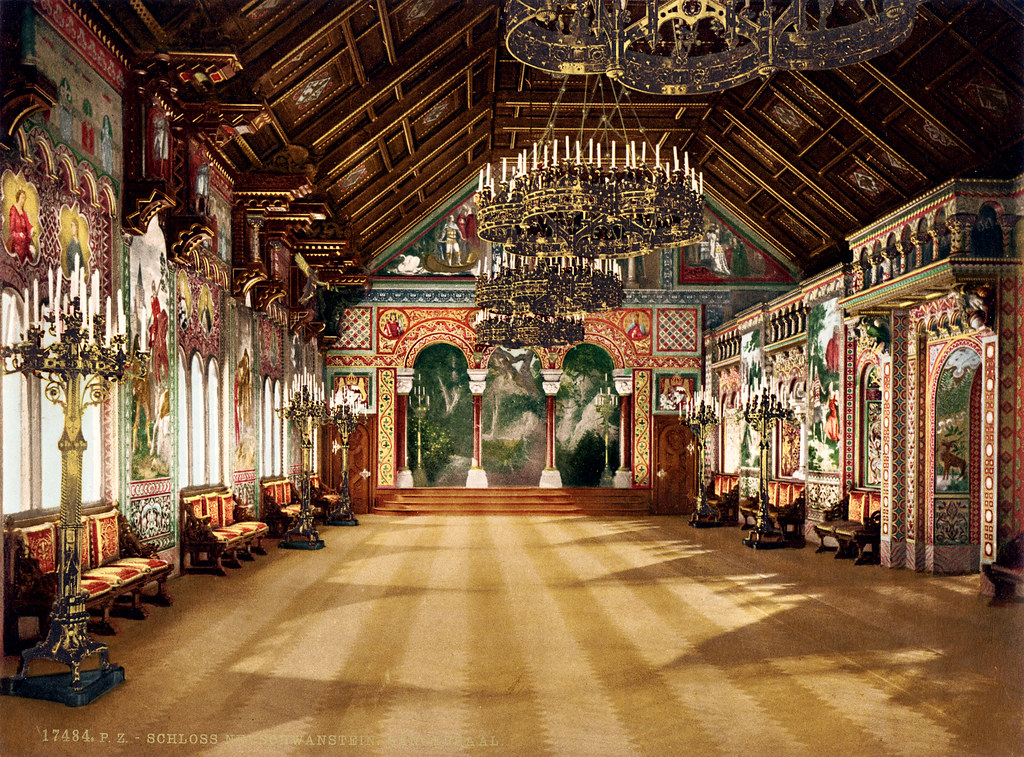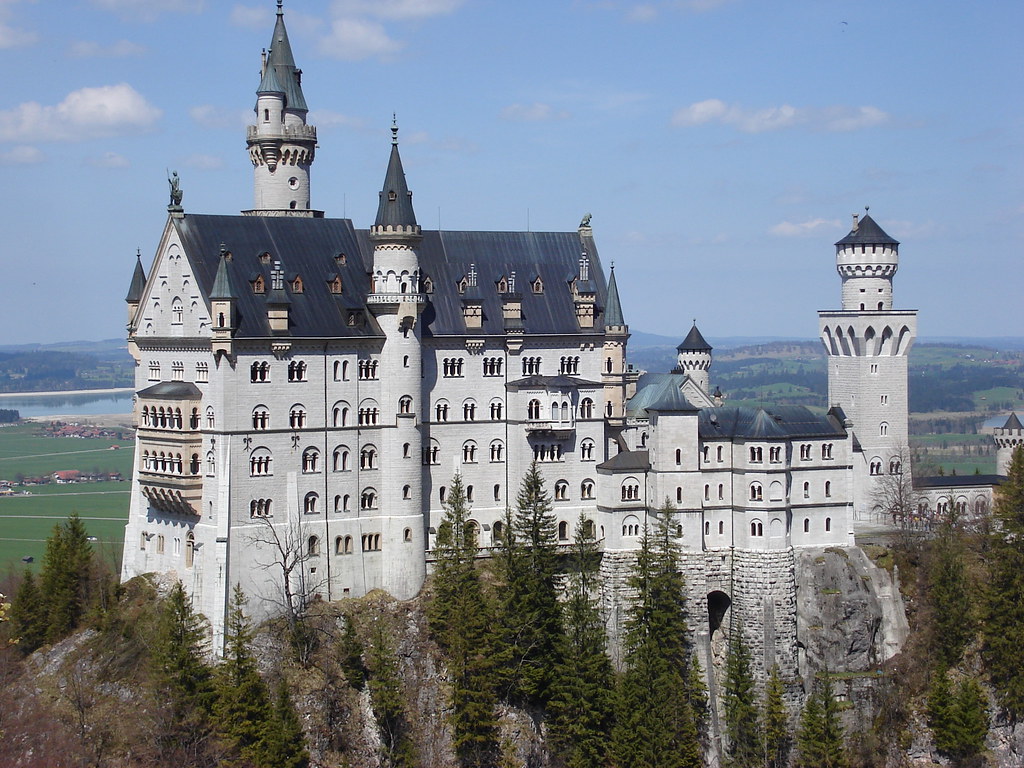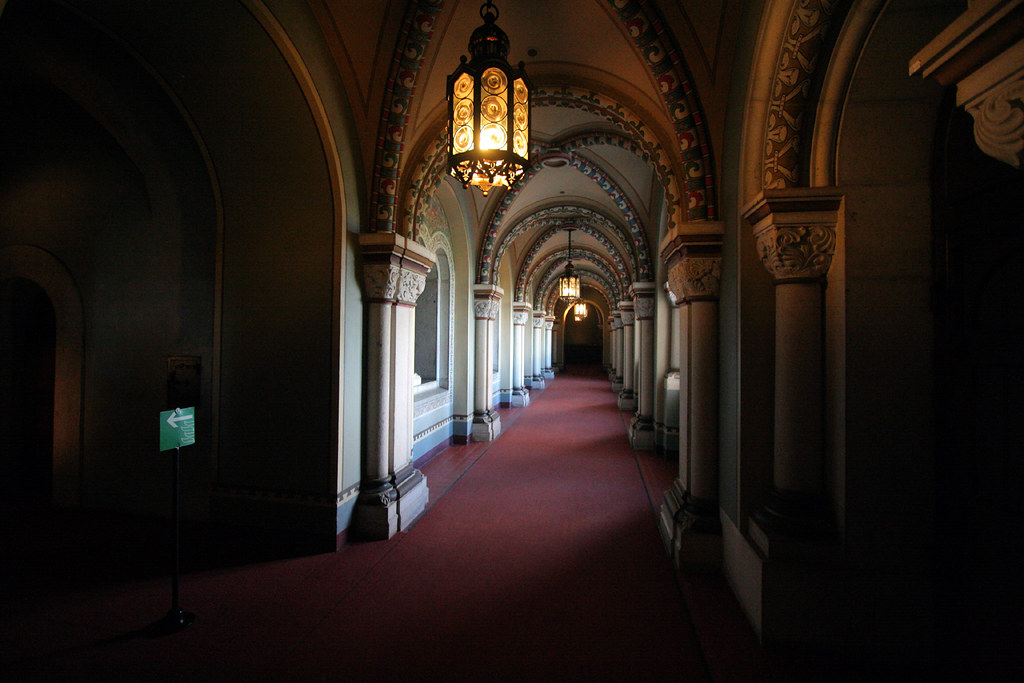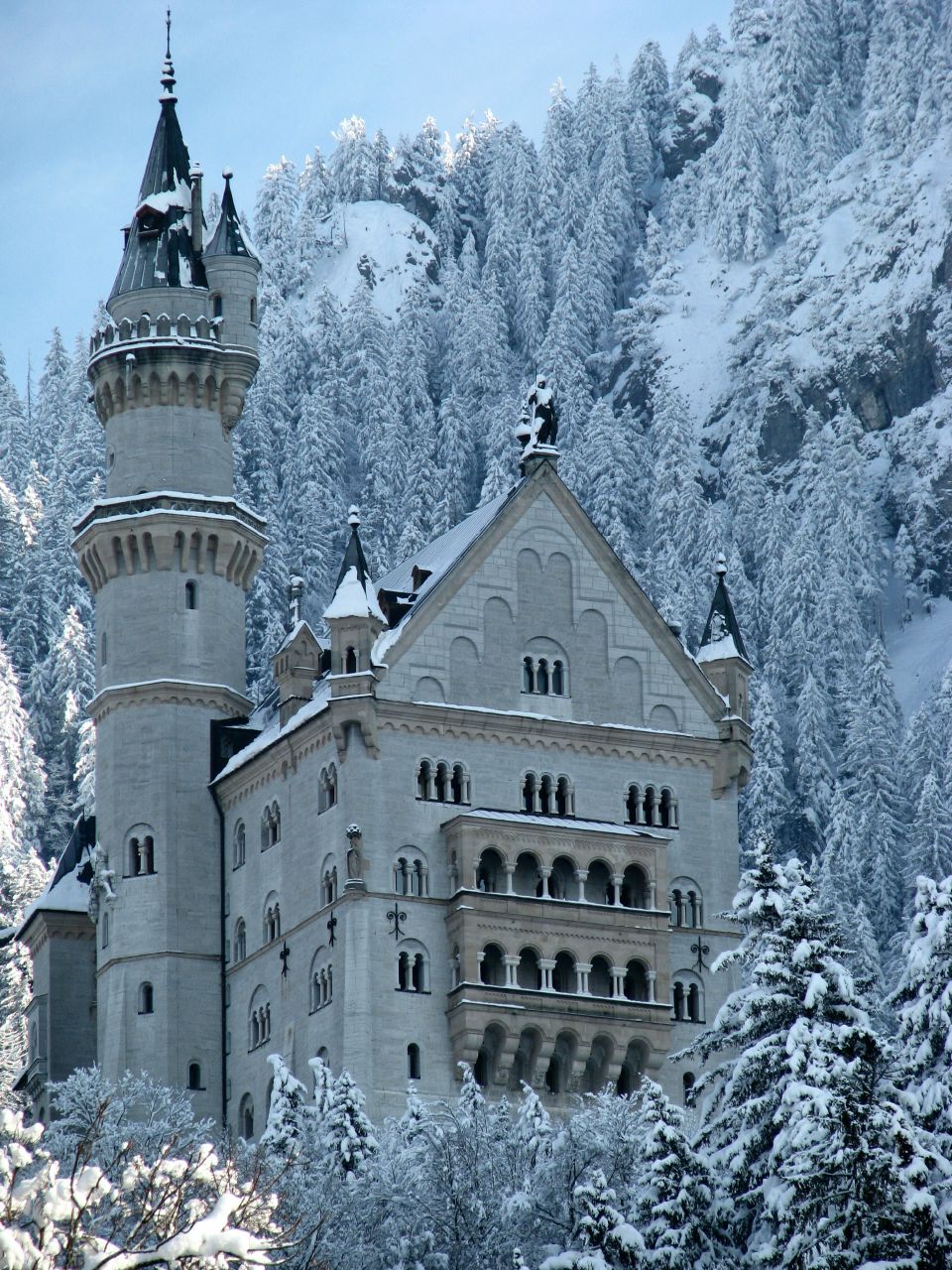Neuschwanstein Castle
Neuschwanstein Castle, royal palace in the Bavarian Alps of Germany, the most famous of three royal palaces built for Louis II of Bavaria, sometimes referred to as Mad King Ludwig, who grew up nearby at Hohenschwangau Castle.
Construction on the castle began in 1869, but given the exact tastes of King Ludwig II, progress was very slow going. As an example, it took 14 carpenters four and a half years just to complete the woodwork in Ludwig's bedroom. The King was an immense devotee of Richard Wagner, even going as far as naming the castle after a character in one of Wagner's operas--the Swan Knight. In none of the other castles in Germany will you find more instances of Ludwig's fondness for Wagner's work. Tapestries depicting scenes from Wagner's opera can be found inside.
Construction on the castle began in 1869, but given the exact tastes of King Ludwig II, progress was very slow going. As an example, it took 14 carpenters four and a half years just to complete the woodwork in Ludwig's bedroom. The King was an immense devotee of Richard Wagner, even going as far as naming the castle after a character in one of Wagner's operas--the Swan Knight. In none of the other castles in Germany will you find more instances of Ludwig's fondness for Wagner's work. Tapestries depicting scenes from Wagner's opera can be found inside.
Construction was halted on the castle and King Ludwig II was removed by power due to intrigue within his own cabinet. The King himself was rarely concerned with matters of state and was sometimes thought to suffer from hallucinations. However, what frightened the cabinet were the rumors of their possible removal. Under Bavarian law, a King could be removed from power if he were found unfit to rule. The cabinet produced this report and deposed of the King. However, Ludwig's mysterious death--ruled a suicide at the time--suggests that the cabinet was not content to merely remove him from power. This bit of mystery makes the atmosphere of Neuschwanstein one of the most intriguing of the castles in Germany.
Unfortunately, many of the rooms in the enchanting castle remained bare. Only 14 rooms were finished before Ludwig's death. Yet the beauty of this famous German castle cannot be denied. The sun reflects magnificently off the pearly walls of Neuschwanstein. Inside, the throne room is the picture of opulence. Intricate frescos of angels and other Christian depictions can be found. There is no throne, only a raised dais at the end of the room, as the King was removed from power before a throne could be built.
Unfortunately, many of the rooms in the enchanting castle remained bare. Only 14 rooms were finished before Ludwig's death. Yet the beauty of this famous German castle cannot be denied. The sun reflects magnificently off the pearly walls of Neuschwanstein. Inside, the throne room is the picture of opulence. Intricate frescos of angels and other Christian depictions can be found. There is no throne, only a raised dais at the end of the room, as the King was removed from power before a throne could be built.
The suite of rooms within the Palas contains the Throne Room, Ludwig's suite, the Singers' Hall, and the Grotto. Throughout, the design pays homage to the German legends of Lohengrin, the Swan Knight. Hohenschwangau, where Ludwig spent much of his youth, had decorations of these sagas. These themes were taken up in the operas of Richard Wagner. Many rooms bear a border depicting the various operas written by Wagner, including a theater permanently featuring the set of one such play. Many of the interior rooms remain undecorated, with only 14 rooms finished before Ludwig's death. With the palace under construction at the King's death, one of the major features of the palace remained unbuilt. A massive keep was planned for the middle of the upper courtyard but was never built, at the decision of the King's family. The foundation for the keep is visible in the upper courtyard.
The finished rooms include the throne room, which features a glass gem-encrusted chandelier; all Twelve Apostles, painted on the wall that surrounds the pedestal for the throne - the actual throne was never finished; and Jesus, behind the pedestal. The King's master suite includes a four-post bed hand carved of wood, the canopy of which is carved as the cathedral towers from every cathedral in Bavaria, a secret flushing toilet (which flushes with water collected from an aqueduct) and a running sink in the shape of a swan. The palace also includes an oratory, accessible from the dressing room and the master suite, which features an ivory crucifix, a room made to look like a cavern, a full kitchen equipped with hot and cold running water and heated cupboards, servants' quarters, a study, a dining room and the Singers' Hall. The Singers' Hall is a venue for performances by musicians and playwrights. The King built it for Wagner as a place to write and perform plays. The King died before watching a performance in the Singers' Hall, but it has been used since the King's death.
It is now almost forgotten that Ludwig II was a patron of modern inventions and that he pioneered the introduction of electricity into public life in Bavaria. His new palaces were the first buildings to use electricity (i.e. the Venus Grotto at Linderhof) and other modern conveniences. Through his building activities, Ludwig kept many particular crafts alive, the knowledge and expertise of which would have died out otherwise, and he provided work and income to artisans, builders, plasterers, and decorators.
It is now almost forgotten that Ludwig II was a patron of modern inventions and that he pioneered the introduction of electricity into public life in Bavaria. His new palaces were the first buildings to use electricity (i.e. the Venus Grotto at Linderhof) and other modern conveniences. Through his building activities, Ludwig kept many particular crafts alive, the knowledge and expertise of which would have died out otherwise, and he provided work and income to artisans, builders, plasterers, and decorators.
Seven weeks after the death of King Ludwig II in 1886, Neuschwanstein was opened to the public. The shy king had built the castle in order to withdraw from public life - now vast numbers of people came to view his private refuge.
Today Neuschwanstein is one of the most popular of all the palaces and castles in Europe. Every year 1.3 million people visit "the castle of the fairy-tale king". In the summer around 6,000 visitors a day stream through rooms that were intended for a single inhabitant.
The setting of Neuschwanstein could not be more idyllic. However, movement in the foundation area has to be continuously monitored, and the sheer rock walls must be repeatedly secured. The harsh climate also has a detrimental effect on the limestone façades, which will have to be renovated section by section over the next few years.
Today Neuschwanstein is one of the most popular of all the palaces and castles in Europe. Every year 1.3 million people visit "the castle of the fairy-tale king". In the summer around 6,000 visitors a day stream through rooms that were intended for a single inhabitant.
The setting of Neuschwanstein could not be more idyllic. However, movement in the foundation area has to be continuously monitored, and the sheer rock walls must be repeatedly secured. The harsh climate also has a detrimental effect on the limestone façades, which will have to be renovated section by section over the next few years.
It is surely the most famous castle in the world — and, like its builder, one of the most misunderstood. Neuschwanstein castle is a structure of contrast, irony, and mystery — and beauty.
One of biggest ironies of this castle is that a structure built to be a private refuge, “sacred and out of reach” (“heilig und unnahbar”), should now be host to thousands of tourists each year. Another irony: although it was built largely as a stage for Wagnerian productions (“a worthy temple for the divine friend [Wagner]”), the composer never set foot in Neuschwanstein. Nor was the castle’s throne room was ever completed in time to contain a throne.
To execute his dream project, the king commissioned a stage designer as architect. The castle that Christian Jank designed for Ludwig inspires awe and surprise in visitors to this day. But in part because the Disneyesque image of Neuschwanstein has become such a cliché, it is easy to dismiss it as an ostentatious example of poor taste, an anachronistic piece of foolishness. Nevertheless, ever since it was opened to the public, Neuschwanstein has acted as a powerful magnet. The castle’s unique location combined with Ludwig’s “fantasy in stone” creates a special magic. But like any work of art, the more one knows about Neuschwanstein, the more one can appreciate it.
One of biggest ironies of this castle is that a structure built to be a private refuge, “sacred and out of reach” (“heilig und unnahbar”), should now be host to thousands of tourists each year. Another irony: although it was built largely as a stage for Wagnerian productions (“a worthy temple for the divine friend [Wagner]”), the composer never set foot in Neuschwanstein. Nor was the castle’s throne room was ever completed in time to contain a throne.
To execute his dream project, the king commissioned a stage designer as architect. The castle that Christian Jank designed for Ludwig inspires awe and surprise in visitors to this day. But in part because the Disneyesque image of Neuschwanstein has become such a cliché, it is easy to dismiss it as an ostentatious example of poor taste, an anachronistic piece of foolishness. Nevertheless, ever since it was opened to the public, Neuschwanstein has acted as a powerful magnet. The castle’s unique location combined with Ludwig’s “fantasy in stone” creates a special magic. But like any work of art, the more one knows about Neuschwanstein, the more one can appreciate it.
The engineering architect was Eduard Riedel (after 1874, Georg Dollmann; from 1886 to 1892 Julius Hofmann), and Neuschwanstein is an engineering marvel. The castle’s construction lasted 23 years, until long after Ludwig’s death. Although built in the Germanic late Romanesque style of the 13th century, the castle was equipped with the best technology available in the late 1860s. Quite unlike any real medieval castle, Neuschwanstein has a forced-air central heating system. Its rarely-used kitchen was of the most advanced design. The winter garden features a large sliding glass door.
Out of all of Ludwig’s amazing “fantasies in stone,” Neuschwanstein seems to be the most fantastic.
With some of the structure still not totally complete, Ludwig moved into Neuschwanstein’s finished rooms for the first time in 1884. The king spent eleven nights in his dream castle from 27 May to 8 June.
Contrary to popular legend, Ludwig’s building projects did not bankrupt the Bavarian treasury. Neuschwanstein, like Ludwig’s other castles, was financed entirely from the king’s own funds.
Out of all of Ludwig’s amazing “fantasies in stone,” Neuschwanstein seems to be the most fantastic.
With some of the structure still not totally complete, Ludwig moved into Neuschwanstein’s finished rooms for the first time in 1884. The king spent eleven nights in his dream castle from 27 May to 8 June.
Contrary to popular legend, Ludwig’s building projects did not bankrupt the Bavarian treasury. Neuschwanstein, like Ludwig’s other castles, was financed entirely from the king’s own funds.








0 comments:
Post a Comment